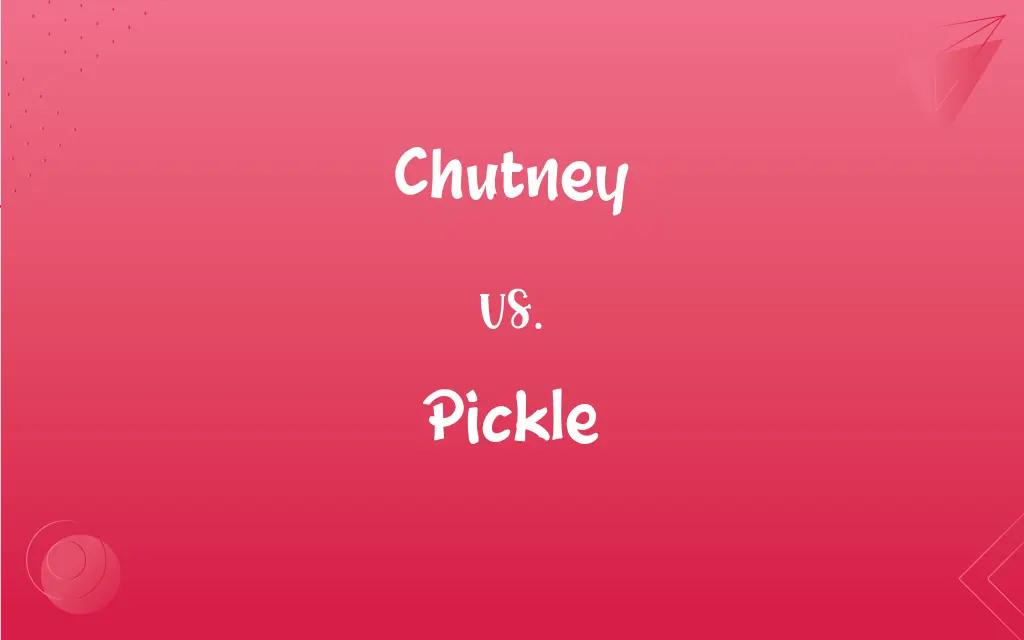Chutney vs. Pickle: What's the Difference?
Edited by Janet White || By Harlon Moss || Updated on October 25, 2023
Chutney is a spicy, often sweet condiment made from fruit or vegetables; pickle is a food item preserved in brine or vinegar.

Key Differences
Chutney and pickle, often staples in diverse cuisines, are unique yet sometimes confused. Chutney, originating from India, is a condiment that blends fruits or vegetables with spices, sugar, and vinegar. This combination creates a savory, tangy, and often sweet flavor profile that complements various dishes.
On the other hand, pickle primarily involves preserving food, usually vegetables or fruits, in a solution of brine or vinegar. This preservation method, utilized for centuries, imparts a tartness to the pickled items, making pickles a crunchy, tangy addition to many meals.
The texture also plays a role in distinguishing between chutney and pickle. While chutney is generally smooth or finely chopped, providing a more unified consistency, pickles maintain their original form and have a distinct, often crunchy texture. It's this tangible difference that can make a sandwich with pickles feel distinct from one spread with chutney.
Another distinction lies in their preparation. Chutneys can be either cooked or raw, emphasizing the melding of flavors. In contrast, pickles undergo a fermentation or curing process in their preserving liquid, enhancing their tangy flavor and increasing their shelf life.
Usage also varies between chutney and pickle. While both can be used as condiments, chutneys often accompany curries, grilled meats, or cheeses, enhancing the dish's flavor profile. Pickles, on the other hand, are frequently served as a side or an ingredient within dishes, adding a burst of tanginess.
ADVERTISEMENT
Comparison Chart
Origin
Traditionally from India.
Ancient practice across various cultures.
Basic Definition
Condiment made from fruits or vegetables with spices.
Food preserved in brine or vinegar.
Texture
Generally smooth or finely chopped.
Maintains original form, often crunchy.
Preparation
Can be cooked or raw.
Undergoes fermentation or curing in preserving liquid.
Typical Usage
Accompanies curries, meats, cheeses.
Served as a side or used as an ingredient in dishes.
ADVERTISEMENT
Chutney and Pickle Definitions
Chutney
A sauce blending sweet, tangy, and spicy flavors.
The mango chutney was a delightful addition to the grilled chicken.
Pickle
A fermented vegetable or fruit.
The cucumber pickle tasted tart and refreshing.
Chutney
An Indian relish with varying textures.
The fresh coconut chutney complemented the dosa perfectly.
Pickle
A method of preserving food for extended shelf life.
Using old family recipes, she would pickle green beans every summer.
Chutney
A mixture of chopped fruits or vegetables with vinegar and spices.
Her homemade apple chutney was the talk of the dinner party.
Pickle
A tangy side dish enhancing meals.
She loved having a pickle with her grilled cheese sandwich.
Chutney
A spicy condiment made of fruits or vegetables.
She paired the samosas with a tangy tamarind chutney.
Pickle
A food item preserved in vinegar or brine.
He added a dill pickle to his sandwich for an extra crunch.
Chutney
A flavorful accompaniment to enhance main dishes.
The roasted lamb was elevated by the mint chutney.
Pickle
A cured food offering tanginess to dishes.
The spicy pickle added a zing to the burger.
Chutney
A pungent relish made of fruits, spices, and herbs.
Pickle
An edible product, such as a cucumber, that has been preserved and flavored in a solution of brine or vinegar.
FAQs
Can chutneys be spicy?
Yes, chutneys can range from sweet to spicy or a combination of both.
What is the primary base for chutney?
Chutney is often made from fruits or vegetables combined with spices.
How is a pickle typically preserved?
A pickle is preserved in brine or vinegar.
Which lasts longer, chutney or pickle?
Typically, pickles have a longer shelf life due to their preservation process.
Can you pickle fruits?
Yes, fruits like apples or pears can be pickled.
Are pickles always cold?
While pickles are often refrigerated, they can be eaten at room temperature.
Are pickles always crunchy?
While many pickles maintain a crunchy texture, some can be softer depending on the pickling process.
Can chutney be made without vinegar?
Yes, not all chutneys contain vinegar.
Why are pickles often sour?
The fermenting process with vinegar or brine imparts a sour taste to pickles.
Is chutney exclusively an Indian condiment?
While chutney originates from India, it has been embraced and adapted by many cultures.
Are pickled cucumbers the only type of pickle?
No, a wide variety of vegetables and fruits can be pickled.
Can chutney be used as a spread?
Yes, chutney can be used as a spread on sandwiches, crackers, and more.
Do chutneys always have a smooth consistency?
No, chutneys can be smooth or have a chunky texture.
What's the shelf life of chutney versus pickle?
While chutneys typically have a shorter shelf life, pickles, due to their preservation method, can last much longer.
Can you eat pickles on their own?
Absolutely, many people enjoy eating pickles as a standalone snack.
Are all pickles fermented?
No, some pickles are simply cured in vinegar without fermentation.
Can pickles be spicy?
Yes, depending on the ingredients used, pickles can be spicy.
Do chutneys always contain sugar?
Not always, but many chutneys have sugar or a sweetening agent to balance flavors.
Which is sweeter, chutney or pickle?
Generally, chutneys tend to be sweeter, though there are exceptions.
Is chutney similar to jam?
While both can be sweet and made from fruit, chutney often includes savory and spicy elements, unlike jam.
About Author
Written by
Harlon MossHarlon is a seasoned quality moderator and accomplished content writer for Difference Wiki. An alumnus of the prestigious University of California, he earned his degree in Computer Science. Leveraging his academic background, Harlon brings a meticulous and informed perspective to his work, ensuring content accuracy and excellence.
Edited by
Janet WhiteJanet White has been an esteemed writer and blogger for Difference Wiki. Holding a Master's degree in Science and Medical Journalism from the prestigious Boston University, she has consistently demonstrated her expertise and passion for her field. When she's not immersed in her work, Janet relishes her time exercising, delving into a good book, and cherishing moments with friends and family.































































